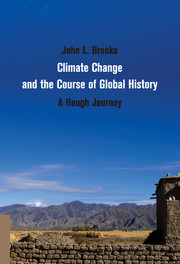Book contents
- Frontmatter
- Dedication
- Contents
- List of Figures and Tables
- Acknowledgments
- List of Abbreviations
- Introduction
- Part I Evolution and Earth Systems
- Part II Domestication, Agriculture, and the Rise of the State
- 3 Agricultural Revolutions
- 4 The Mid-Holocene, the Late Neolithic, and the Urban-State Revolution
- 5 Human Well-Being from the Paleolithic to the Rise of the State
- Part III Ancient and Medieval Agrarian Societies
- Part IV Into the Modern Condition
- Data Bibliography: Full Citations for Data Used in Figures and Tables
- Index
- References
5 - Human Well-Being from the Paleolithic to the Rise of the State
Published online by Cambridge University Press: 05 August 2014
- Frontmatter
- Dedication
- Contents
- List of Figures and Tables
- Acknowledgments
- List of Abbreviations
- Introduction
- Part I Evolution and Earth Systems
- Part II Domestication, Agriculture, and the Rise of the State
- 3 Agricultural Revolutions
- 4 The Mid-Holocene, the Late Neolithic, and the Urban-State Revolution
- 5 Human Well-Being from the Paleolithic to the Rise of the State
- Part III Ancient and Medieval Agrarian Societies
- Part IV Into the Modern Condition
- Data Bibliography: Full Citations for Data Used in Figures and Tables
- Index
- References
Summary
What then of human welfare? How did humans fare during the millennia between the end of the Pleistocene, and the close of great eons of a hunter-gatherer existence, and the rise of civilizations during the Mid-Holocene transition? And, in particular, how did the transition to agriculture affect human fortunes? Here we need to start with human numbers and human health, the fundamental measures of the human condition in historical time. Working out this demographic history of ancient peoples from archaeological remains is no easy matter, and the labors of numerous scholars have established only the outlines of working hypotheses. This chapter explores these hypotheses and proposes a tentative synthesis.
Human Health in the Paleolithic
The first part of this story must necessarily be sketched only lightly. The conditions of health during the Paleolithic, and indeed back into the roots of the genus Homo, are the subject of considerable speculation, based on slim but improving archaeological and genetic information.
Very broadly speaking, the health of proto-human and early human populations was shaped by their ecological circumstances. As climate began to swing toward widening extremes from the late Pliocene into the Pleistocene, small, isolated bands of opportunistic primate foragers and predators were pushed from tropical forest environments toward increasingly dry savannah grasslands. These conditions contributed not only to changes in their diet, but to their exposure to disease. Contact with hunted animals or hand-grubbed soils would have exposed early humans to various viral and bacterial infections and insect and worm parasites, just as they would have any other similar animal species. Perhaps both their low population densities and their trajectory into dry savannah grasslands would have reduced the cumulative impact of this disease exposure. But spread thinly across belts of open territory in Africa and across Eurasia, early humans would have been continuously exposed to small, sharp, local surges of disease that would have decimated the peoples of discrete territories before they burned out.
- Type
- Chapter
- Information
- Climate Change and the Course of Global HistoryA Rough Journey, pp. 213 - 242Publisher: Cambridge University PressPrint publication year: 2014



